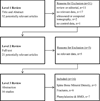A systematic review of bone mineral density and fractures in phenylketonuria
- PMID: 25005329
- PMCID: PMC4208974
- DOI: 10.1007/s10545-014-9735-2
A systematic review of bone mineral density and fractures in phenylketonuria
Abstract
Introduction: Our objective was to systematically review and analyze published data on bone mineral density (BMD) and fracture rates in patients with phenylketonuria (PKU), and relationships between BMD and phenylalanine levels.
Methodology: We searched PubMed, CINAHL, and Cochrane databases from January 1966 to November 2013 for studies of spine BMD or fracture in PKU and control subjects. We excluded studies assessing skeletal health by ultrasound or peripheral quantitative computer tomography. Both authors reviewed abstracts for inclusion, and read full text papers to extract data.
Results: Sixteen studies met eligibility criteria. Meta-analysis of three studies found that spine BMD was 0.100 g/cm(2) lower (95% CI, -0.110, -0.090 g/cm(2)) in 67 subjects with PKU, compared to 161 controls. Among six studies, 20% (53 of 263) of PKU subjects experienced clinical fractures. In the single study with controls, the fracture rate was 2.6 fold higher (95% CI, 1.1-6.1) after age 8 in PKU subjects, compared to healthy sibling controls. When considering a total of 12 studies in 412 subjects, nine or 75% of studies representing 71% of studied subjects reported no association between phenylalanine levels and BMD. Spine BMD is lower in PKU than control subjects, but only one study controlled for smaller body size. Existing studies suggest a clinical fracture rate of 20% among PKU subjects, but fracture rates in controls are lacking. Finally, existing data shows no consistent relationship between phenylalanine levels and BMD. Future studies are needed to clarify the etiology and health consequences of low BMD in PKU.
Conflict of interest statement
Karen Hansen is a consultant to Takeda Pharmaceuticals and Deltanoid Pharmaceuticals.
Denise Ney is a co-inventor on US Patent 8,604,168 B2, Glycomacropeptide Medical Foods for Nutritional Management of Phenylketonuria and other Metabolic Disorders, held by the Wisconsin Alumni Research Foundation and licensed to Cambrooke Therapeutics, LLC.
Figures





References
-
- National Institutes of Health Consensus Development Conference Statement: phenylketonuria: screening and management, October 16–18, 2000. Pediatrics. 2001;108(4):972–982. - PubMed
-
- Adamczyk P, Morawiec-Knysak A, Pludowski P, et al. Bone metabolism and the muscle-bone relationship in children, adolescents and young adults with phenylketonuria. J Bone Miner Metab. 2010;29(2):236–244. - PubMed
-
- Al-Qadreh A, Schulpis KH, Athanasopoulou H, et al. Bone mineral status in children with phenylketonuria under treatment. Acta Paediatr. 1998;87(11):1162–1166. - PubMed
-
- Allen JR, Humphries IR, Waters DL, et al. Decreased bone mineral density in children with phenylketonuria. Am J Clin Nutr. 1994;59(2):419–422. - PubMed
-
- Allen JR, Humphries IR, Waters DL, et al. Decreased bone mineral density in children with phenylketonuria. The American journal of clinical nutrition. 1994;59(2):419–422. - PubMed
Publication types
MeSH terms
Substances
Grants and funding
LinkOut - more resources
Full Text Sources
Other Literature Sources
Medical
Miscellaneous

